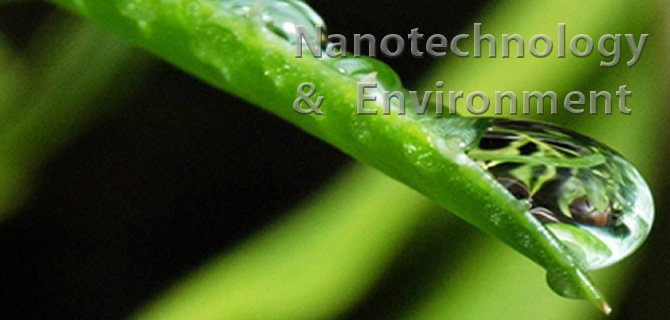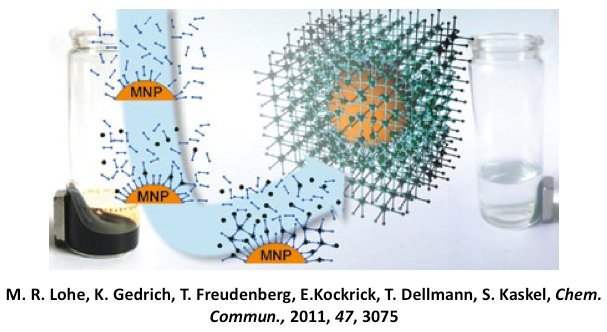Nanotechnology in the Environment

Source
Nanotechnology, by working on a scale equal to or less than 0.1 thousandths of a millimeter, allows the development of new materials and applications that are used in multiple industrial sectors. Some experts talk about a technological revolution that is expanding in the coming years.
In the environmental area, the opportunities are also enormous, both for traditional activities and for the new business scope, such as the identification of particles, the identification of environmental impacts or the ecodesign of nanomaterials.
Nanotechnology has launched new environmental products to prevent erosion and clean up contaminated sites. It is possible, for example, to protect the devastated land by means of a component that favors the stabilization of the soil.
There is an organic and biodegradable product, which undergoes electrochemical reactions at a level of four nanometers mixed with water. The reaction causes that between the silicates of the soil and the silicates of the product, a self-assembly takes place, forming a type that remains for a year. The crust prevents the dragging of the soil (erosion) and allows the germination of crust and root of the seeds mixed with the product.
Among these sectors, remediation experiences the fastest growth. In this case, there is already talk of soil decontamination and water treatment, waste treatment, and recycling of materials, control of substances throughout their life cycle, "nanofiltration" or "photocatalytic degradation". However, experts remember that there are still to be defined and designed the most appropriate materials for it.
For example, a sector on the verge of undergoing a great transformation is the analytical chemistry, that will be able to have detection and monitoring techniques much more sensitive than the current ones. For example, nanosensors for the detection of gases or chemicals and in situ analysis and portable applications are thought. Likewise, protection, maintenance, and environmental improvement are other sectors with more possibilities of growth for the coming years.

Source
Eco-efficiency is also another sector with high expectations. The properties of the materials will improve, to be lighter for example; you can get very efficient LED lamps and heat-electricity direct conversion systems.
On the other hand, the areas of research to which fewer resources are allocated are the understanding of natural processes and the development of nanomaterials for applications that imitate natural processes. Although nanotechnology has a large number of positive applications for humanity, this in the near future could present certain risks for the environment.
Nanotechnology is expected to be the transformative technology of this century for its ability to reconstruct familiar substances or to create new materials and products with new properties and functions. Nanotechnology will fundamentally restructure the technologies currently in use for manufacturing, medicine, defense, energy production, environmental management, transportation, communications, computing, and education. The applications in nanotechnology.

Source
Risks for the Environment
Experts remember that the potential environmental effects of manufactured nanoparticles are quite unknown. In the laboratory, scientists control it quite well, but in the environment, the possible interactions are much greater, so more research is recommended. In this sense, "nanoecotoxicology" is still a nascent discipline.
For example, nanoparticles could react with substances present in the medium or catalyze reactions present in the medium. They could even become toxic to microorganisms in the environment, which could lead to a bioaccumulation of toxicity in the trophic chain that would reach magnified humans.
As for consumer products, the Government Institute for Health and Environment of the Netherlands (RIVM) ensures that the greatest risk is contained by the free nanoparticles used in cleaning products, cosmetics, and personal care products, while the incorporated nanomaterials in applications, such as electronics, sports equipment or coatings present a lower risk.
In any case, most experts agree that although some nanomaterials may have negative effects on the environment, that same knowledge can serve to overcome the problem. For example, nanotechnology itself could be used for new systems that analyze the effects of these nanoparticles, both natural and artificial

Source
Benefits of Nanotechnology: Environment
The degradation of the environment is one of the most important problems of today and one that has many sources and causes.
One of the major causes of environmental deterioration is intensive agriculture. But the use of greenhouses for agricultural production would, in turn, reduce the consumption of water, land, and damage to the land. The extraction of minerals from the earth is another problem, but with nanotechnology, there will be much less need for minerals and it will be possible to close many mines.
It will also be possible to limit much more the number of production factories whose activity seriously pollutes the environment. In general, new technologies allow the development of polluting activities to be more compact and controlled, and the more economic manufacturing allows improvements to be incorporated at a relatively low cost.
Storable solar energy will reduce emissions of ash, soot, hydrocarbon, NOx, CO2 and, oil.
In most cases, there will be very strong economic incentives to apply new, more efficient technologies as quickly as possible. Even in those areas that do not have a technological infrastructure, self-contained molecular manufacturing would allow the rapid development of technology that does not harm the environment.

Source
For more information visit the following links.
https://www.nanowerk.com/nanotechnology-and-the-environment.php
http://www.understandingnano.com/environmental-nanotechnology.html
https://www.sciencedirect.com/science/article/pii/S1369702110700894
Great Post! Thats so interesting
Nice summary. Let's hope this technology matures sooner rather than later, while we can still profit from it and our climate isn't completely shot!
Thanks so are. Hopefully, it will develop quickly.